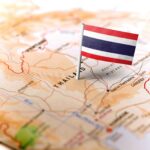Choosing the right location for your factory in Thailand is a crucial decision that can greatly impact your business’s operational efficiency and overall success. From logistics to zoning regulations, various factors can influence the ideal site for your operations. This guide will explore key factors for factory location selection in Thailand, outline the top industrial regions, and show you how to leverage incentives to optimize your factory setup.
Key Considerations for Factory Location Selection in Thailand
1. Location Proximity
Proximity to raw materials and supply sources is crucial for efficient factory operations. A factory close to suppliers or customers can significantly reduce transportation costs. For industries like food processing or heavy manufacturing, being near supply sources or export ports streamlines production and distribution. Also, ensure access to essential utilities like electricity, water, and internet to avoid disruptions.
2. Understanding Land Zoning Regulations
Navigating Thailand’s zoning laws is key to successful factory setup. The country’s zoning system is color-coded, with industrial operations allowed in “purple zones.” These zones are designated for factories and warehouses, streamlining permits and approvals. Selecting a location within these zones helps prevent delays in setting up your factory and ensures compliance with local regulations.
3. Assessing Safety and Environmental Risks
Consider environmental factors like flood risks when selecting a factory location. Factories on elevated land have better protection against flooding, a common issue in some Thai regions. Traffic conditions in the area are also important; factories in congested zones may experience delays, affecting production schedules. Understanding these risks helps in choosing a safe and reliable location for your factory.
4. Budget and Land Costs
Land costs vary significantly based on location and proximity to infrastructure. Industrial estates near highways, seaports, or cities tend to be more expensive but offer better connectivity. Consider both the initial land price and potential savings from improved logistics. Analyzing long-term expenses helps you optimize the overall budget for your factory location selection in Thailand.
Top Regions for Factory Location in Thailand
1. Eastern Seaboard and the Eastern Economic Corridor (EEC)
The Eastern Seaboard, including Chonburi, Rayong, and Chachoengsao, is Thailand’s most developed industrial zone. It is near Laem Chabang Port, making it ideal for export-driven businesses. The EEC focuses on high-tech industries like aerospace and robotics. With government incentives and advanced infrastructure, it’s a prime location for growth.
2. Central Plains
The Central Plains, home to provinces like Nakhon Sawan, is known for agriculture and food processing industries. Its central location and good access to Bangkok make it suitable for businesses serving local and regional markets. This region is particularly advantageous for factory location selection in Thailand for agribusinesses.
3. Western Seaboard
This newer industrial hub includes areas like Prachuap Khiri Khan and Phetchaburi. It is well-suited for heavy manufacturing industries such as electronics, textiles, and automotive production. Its location near Bangkok and Laem Chabang Port supports businesses involved in export.
4. Upper North
For businesses aiming to minimize setup costs, the Upper North is an attractive choice. Provinces like Phitsanulok offer lower land costs and support light industries such as textiles and ceramics. This region’s access to skilled labor makes it ideal for companies with lower environmental impact.
Industrial Zones and Incentives in Thailand
1. General Industrial Zones
General industrial zones are ideal for businesses producing goods for Thailand’s domestic market. They offer services like transportation, warehousing, and utilities. Businesses can also own land within these zones, simplifying the setup process and allowing for more stable operations.
2. IEAT Free Zones
These zones cater to export-focused businesses, offering tax advantages. Companies operating in IEAT Free Zones are exempt from import duties on machinery and raw materials. They also enjoy reduced taxes on exported goods. Streamlined customs procedures make it easier to manage both imports and exports.
Non-Tax Incentives for Industrial Zones
The Industrial Estate Authority of Thailand (IEAT) offers additional non-tax benefits, such as:
- Land ownership rights for foreign investors.
- Residency permits for key staff and families.
- Permission to bring experts for specialized projects.
- No restrictions on remitting foreign currency abroad.
These incentives help simplify the factory setup process, allowing businesses to focus on growth and productivity.
Conclusion: Optimize Your Factory Location Selection in Thailand
Choosing the right factory location in Thailand influences logistics, production efficiency, and overall business success. By carefully considering factors like proximity to resources, zoning regulations, safety, and costs, you can find the ideal site for your operations. With well-developed industrial zones and a range of attractive incentives, Thailand offers a conducive environment for businesses. Contact SparkUp Solutions to guide you through the process and ensure a smooth factory setup.
Ready to Set Up Your Factory in Thailand?
Choosing the right industrial location is key to your business success, and SparkUp Solutions is here to guide you every step of the way. Whether you need help with location scouting, understanding zoning laws, or navigating government incentives, our expert team is ready to provide you with tailored solutions.
Contact us today to schedule a consultation and take the first step toward establishing your factory in Thailand. Let us help you turn your plans into reality





